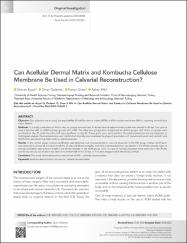Can Acellular Dermal Matrix and Kombucha Cellulose Membrane Be Used in Calvarial Reconstruction?
Künye
Boyalı O, Özdemir Ö, Diren F, Bilir A. (2023). Can Acellular Dermal Matrix and Kombucha Cellulose Membrane Be Used in Calvarial Reconstruction?. J Acad Res Med 2023;13 (2): 82-7Özet
Amaç: Amacımız aselüler dermal matriks (ADM) ve Kombucha membranının (KM) kalvarial dura onarımında uygulanabilirliğini araştırmaktı.
malzeme kusurları.
Yöntemler: Wistar sıçanları üzerinde yapılan bir çalışmada altı grup oluşturuldu. Tüm sıçanlarda dorsal kalvarial subperiosteal cep oluşturuldu. İki grup
bir ADM ve iki gruba da KM implante edildi. Diğer iki grup ise kontrol grubu olarak belirlendi. Altı grubun yarısı
30. günde sakrifiye edildi, diğer yarısı ise 60. günde sakrifiye edildi. Doku greftleri subperiosteal cepten çıkarıldı ve
histolojik analiz. Hematoksilen-eozin ve periyodik asit içeren örnekler hazırlanarak neovaskülarizasyon ve kalsifikasyon yoğunluğu incelendi.
Schiff lekeleri ve bunları ışık mikroskobu altında gözlemlemek.
Bulgular: Kontrol grubunda yoğun kalsifikasyon gözlendi ancak neovaskülarizasyon gözlenmedi. KM grubunda yoğun kalsifikasyon
hem 30 günlük hem de 60 günlük numunelerde hemen hemen tüm hayvanlarda gözlendi ve 30 günlük hayvanlarda neovaskülarizasyon mevcut olmasa da,
60 günlük hayvanların yarısında neovaskülarizasyon mevcuttu. ADM grubunda 30 günlük takipte neovaskülarizasyon bulgusuna rastlanmazken
ve 60 günlük dokularda, 30 günlük hayvanların yarısından fazlasında kalsifikasyon görüldü ve 60 günlük hayvanlarda ortadan kayboldu.
Sonuç: Bu çalışma KM'nin kalvarial rekonstrüksiyonda potansiyel kullanımını göstermektedir. Objective: Our objective was to study the applicability of acellular dermal matrix (ADM) and Kombucha membrane (KM) in repairing calvarial dura mater defects. Methods: In a study conducted on Wistar rats, six groups were formed. A dorsal calvarial subperiosteal pocket was created in all rats. Two groups were implanted with an ADM and two groups with a KM. The other two groups were designated as control groups. Half of the six groups were sacrificed on day 30, while the other half were sacrificed on day 60. Tissue grafts were removed from the subperiosteal pocket and subjected to histological analysis. Neovascularization and calcification intensity were examined by preparing samples with hematoxylin-eosin and periodic acid Schiff stains and observing them under a light microscope. Results: In the control group, intense calcification was observed, but neovascularization was not observed. In the KM group, intense calcification was observed in almost all animals in both the 30-day and 60-day samples, and while neovascularization was absent in the 30-day animals, signs of neovascularization were present in half of the 60-day animals. In the ADM group, while no signs of neovascularization were observed in the 30-day and 60-day tissues, calcification was seen in more than half of the 30-day animals and disappeared in the 60-day animals. Conclusion: This study demonstrates the potential use of KM in calvarial reconstruction.

















